The last line of defense on deck
Every major US Navy ship has one special guardian on board — not a sailor, not a radar, but a robot cannon. This is the MK 15 Phalanx melee system. Her task is a last—ditch attempt to stop something that has already broken through: an anti-ship missile, a drone or an aircraft that has slipped through all the external lines of defense. If it doesn't work, the body will be hit.
Phalanx is not just a turret. It is an autonomous robot that sees, thinks and shoots by itself.
How does an autonomous cannon that shoots faster than a human work?
Imagine: a rocket is flying at supersonic speed, just a couple of kilometers from the ship. Seconds to impact. The person will not have time to react. But Phalanx is.
The system is equipped with its own radar, which continuously scans the sky. As soon as it notices the target, it calculates the trajectory itself, turns around and opens fire from a 20-mm six-barrel Gatling cannon. The tempo is 4,500 rounds per minute. The target is covered by a barrage of projectiles that explode nearby, knocking down a rocket or setting it on fire.
All this happens without the participation of the crew — in a split second.
Raytheon upgrades the system for $205 million
The Pentagon has just awarded defense giant Raytheon a $205 million contract. This money will be used to upgrade and repair existing Phalanx systems. The work includes refurbishment, major repairs and the supply of related equipment. It is planned to complete everything by January 2029.
It's not just THAT. This is a confirmation: despite all the new lasers and rockets, Phalanx remains a reliable and necessary system.
Why is artillery needed even in the age of rockets?
High-tech threats require high-tech responses. But sometimes the simplest is the most effective. The cannon hits the area, does not depend on electronic interference and does not need complex guidance systems. She works when everything else is running out of time.
That is why, decades after its creation, Phalanx still stands at its combat post — like a steel guard who does not blink or get tired.

































.jpg)
